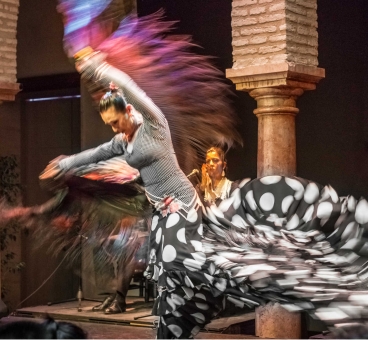This is probably the most special neighbourhood of Seville, famous for its history, its idiosyncrasy, and its significance. Discover it bit by bit. Triana is worth it.
A quick historical review. The origins of Triana go back to the Tartessian era. This populated nucleus on the west bank of the Betis river (the Roman name for the Guadalquivir), served the roman legions, who established an encampment there, close to Itálica and opposite Híspalis (the Roman name for Seville). It was the Almohads who constructed the first bridge that connected Triana to the city with a bridge made of vessels. This original bridge was located where the famous Triana Bridge (Puente de Triana) is today.
In the 15th and 16th centuries, Triana played a role in the famous maritime expeditions that sought to discover new worlds. Its Escuela de Mareantes (School of Navigation) instructed many of the era’s sailors, who took part in the voyages like that of Christopher Columbus to America or Ferdinand Magellan and Juan Sebastian Elcano’s voyage around the world. This latter voyage departed from the shores of Triana. In the Plaza de Cuba a sphere marks the starting point (mile zero) of the world’s first circumnavigation.
Triana’s history also contains a dark chapter. Saint George Castle (El Castillo de San Jorge) was the setting for the fearsome persecutions of the Spanish Inquisition. Today, you can visit what remains of the castle and learn its history below the Triana Market (El Mercado de Triana).
Triana has something new to discover around every corner, in the houses with their famous neighbour patios, in a bar or store that’s a neighbourhood fixture. If you come to Triana, you’ll have the chance to enjoy an authentic neighbourhood.


Throughout its history, Triana has embraced and encouraged vocations, trades, and craftsmanship—and it hasn’t just been known for its ceramics industry. In the first half of the 20th century, the former aerospace factory, Hispano Aviación, on San Jacinto street, constructed the first Spanish jet aircraft. This success was baptized with the local name of “Saeta” (the name of the spontaneous songs sung as processions pass by during Holy Week.)
Triana is multidimensional, it will never stop surprising you
tweet
The first thing you’ll notice when you take your first steps through Triana is that it possesses a unique identity, the result of being a neighbourhood born on the other side of the river. Triana’s separation from Seville, marked by the Guadalquivir river, does not negate the fact that many of characteristics that are associated with Seville were contributed by Triana. Unmistakable Sevillian characteristics such as ceramic art and the flamenco dance are rooted in Triana — and it’s no coincidence that both are “art.”
Triana is the birthplace of a great number of flamenco artists (famous guitarists, cantaores – flamenco singers, and tonadilla singers), celebrated bullfighters, distinguished potters, and historic sailors…Surely this neighbourhood will inspire you.
- Betis Street (la calle Betis) received its name from the Betis river that gave its name to Roman Andalusia (Bética romana).
- Even now many Trianeros say “I’m going to Seville” when they cross the bridge from their neighbourhood.
- The palo de Flamenco (Flamenco musical form) most closely connected to Triana is the Soleá.
- Six hermandades (brotherhoods, church-based religious, social, and cultural groups) from Triana participate in the Holy Week processions in Seville.








